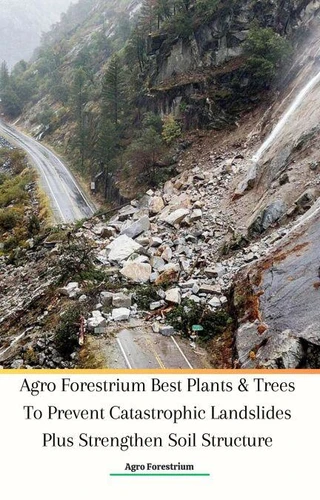Agro Forestrium Best Plants & Trees To Prevent Catastrophic Landslides Plus Strengthen Soil Structure
Par :Formats :
Disponible dans votre compte client Decitre ou Furet du Nord dès validation de votre commande. Le format ePub est :
- Compatible avec une lecture sur My Vivlio (smartphone, tablette, ordinateur)
- Compatible avec une lecture sur liseuses Vivlio
- Pour les liseuses autres que Vivlio, vous devez utiliser le logiciel Adobe Digital Edition. Non compatible avec la lecture sur les liseuses Kindle, Remarkable et Sony
 , qui est-ce ?
, qui est-ce ?Notre partenaire de plateforme de lecture numérique où vous retrouverez l'ensemble de vos ebooks gratuitement
Pour en savoir plus sur nos ebooks, consultez notre aide en ligne ici
- FormatePub
- ISBN8231211357
- EAN9798231211357
- Date de parution18/06/2025
- Protection num.pas de protection
- Infos supplémentairesepub
- ÉditeurWalzone Press
Résumé
Landslides are a type of natural disaster that involve the downward movement of a mass of soil, rocks, and debris on a slope or hillside. They can occur in various forms, such as rockfalls, rockslides, mudslides, or debris flows, depending on the materials involved and the velocity of movement. Landslides are typically triggered by a combination of factors, including heavy rainfall, earthquakes, volcanic eruptions, erosion, changes in groundwater level, slope instability, or human activities such as construction and deforestation.
These factors can weaken the stability of the slope, causing it to fail and result in the movement of materials downslope. The destructive power of landslides can be significant, as they can damage or destroy structures, roads, and infrastructure in their path. They can also lead to loss of life and cause severe environmental damage, particularly when they occur in populated areas or near water bodies.
To mitigate the risks associated with landslides, various measures can be taken, including slope stabilization techniques, land-use planning to avoid vulnerable areas, early warning systems, and emergency preparedness. It is important for communities living in landslide-prone areas to be aware of the potential hazards and take appropriate precautions to minimize the impact of such events. Certain plants and trees can play a role in preventing landslides by stabilizing slopes and reducing soil erosion.
These factors can weaken the stability of the slope, causing it to fail and result in the movement of materials downslope. The destructive power of landslides can be significant, as they can damage or destroy structures, roads, and infrastructure in their path. They can also lead to loss of life and cause severe environmental damage, particularly when they occur in populated areas or near water bodies.
To mitigate the risks associated with landslides, various measures can be taken, including slope stabilization techniques, land-use planning to avoid vulnerable areas, early warning systems, and emergency preparedness. It is important for communities living in landslide-prone areas to be aware of the potential hazards and take appropriate precautions to minimize the impact of such events. Certain plants and trees can play a role in preventing landslides by stabilizing slopes and reducing soil erosion.
Landslides are a type of natural disaster that involve the downward movement of a mass of soil, rocks, and debris on a slope or hillside. They can occur in various forms, such as rockfalls, rockslides, mudslides, or debris flows, depending on the materials involved and the velocity of movement. Landslides are typically triggered by a combination of factors, including heavy rainfall, earthquakes, volcanic eruptions, erosion, changes in groundwater level, slope instability, or human activities such as construction and deforestation.
These factors can weaken the stability of the slope, causing it to fail and result in the movement of materials downslope. The destructive power of landslides can be significant, as they can damage or destroy structures, roads, and infrastructure in their path. They can also lead to loss of life and cause severe environmental damage, particularly when they occur in populated areas or near water bodies.
To mitigate the risks associated with landslides, various measures can be taken, including slope stabilization techniques, land-use planning to avoid vulnerable areas, early warning systems, and emergency preparedness. It is important for communities living in landslide-prone areas to be aware of the potential hazards and take appropriate precautions to minimize the impact of such events. Certain plants and trees can play a role in preventing landslides by stabilizing slopes and reducing soil erosion.
These factors can weaken the stability of the slope, causing it to fail and result in the movement of materials downslope. The destructive power of landslides can be significant, as they can damage or destroy structures, roads, and infrastructure in their path. They can also lead to loss of life and cause severe environmental damage, particularly when they occur in populated areas or near water bodies.
To mitigate the risks associated with landslides, various measures can be taken, including slope stabilization techniques, land-use planning to avoid vulnerable areas, early warning systems, and emergency preparedness. It is important for communities living in landslide-prone areas to be aware of the potential hazards and take appropriate precautions to minimize the impact of such events. Certain plants and trees can play a role in preventing landslides by stabilizing slopes and reducing soil erosion.





